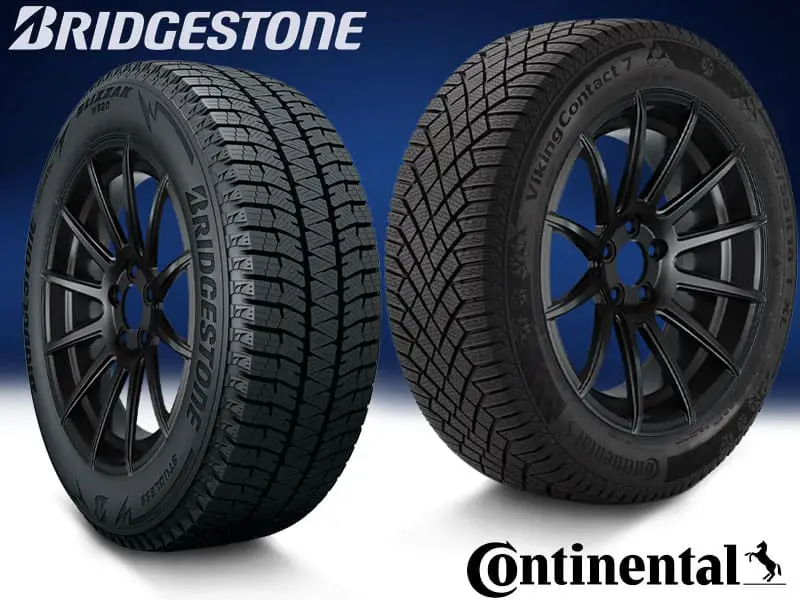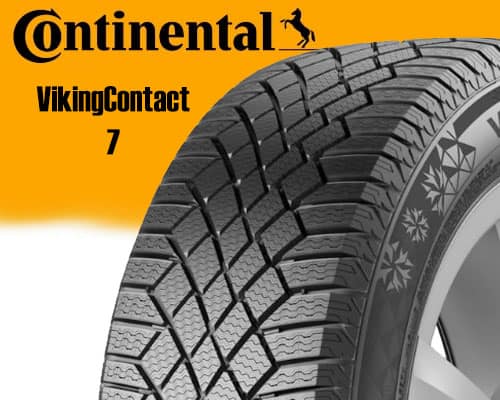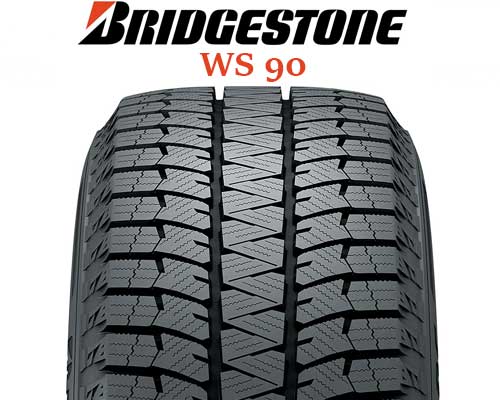Bridgestone Blizzak WS90 and Continental Viking Contact 7 are both winter tires built for trouble-free performance in cold weather. WS90 gives an optimized experience on both wet and dry roads along with an extensive grip on ice.
On the other side, VikingContact 7 gives wonderful traction on snow-covered pathways and offers a quieter ride on road.

Let’s dive in.
Table of Contents
Comparing Continental VikingContact 7 with Blizzak WS90:

Vs

Tread of Blizzak WS90 has a unique central, crisscross rib which continues circumferentially without any lateral void, two longitudinal grooves are located on its sides and a disjointed groove is formed by a notching pattern on each of the shoulders and its lugs are marked by numerous full-depth sipes as well as traction notches.
Its contact patch is higher due to narrow grooves and continuous central rib, as a result, the tread can grip strongly over the road. Efficient hydroplaning is credited to deeper grooves and full-depth, multidirectional, zigzag sipes which wipe away water and account for firm traction over wet and icy paths.
However, a low void ratio makes its performance over snow-covered surfaces lesser than its competitor as its snow evacuation capacity is decreased due to narrow grooves.
On the other hand, the Continental Contact 7 exhibits an aggressive tread pattern due to six zigzag grooves among the symmetrical arrangement of square-shaped blocks, sipes having a wavy design, and several lateral grooves present among shoulder lugs. Increased number of grooves decreases contact patch which eventually causes a reduction in the dry grip of tread, thus, it allows less traction on a dry road. On a wet or icy road, its zigzag grooves and curvy sipes account for reliable hydroplaning resistivity as water moves out through them yet decreased water holding capacity of grooves due to their comparatively lesser depth make it stand below its competitor in this respect. In snow-packed areas, more grooves give the benefit of better snow evacuation through the tread, leading to superior snow traction.
Road Grip Comparison
The Blizzak S90 shows superior grip (even with Michelin tires) on the dry paved surface as it possesses narrower grooves in comparison and the contact patch is higher, as a result, the tread can hold on the road strongly.
Central, crisscross, continuous rib provides the supreme biting ability and further enhances its dry traction. Its dry braking distance is only 88.10 feet when stopped from 50-0 mph.
On a wet and icy road, relatively increased depth of grooves favors it against hydroplaning by providing more water holding capacity and leading to better traction.
It covers 128.60 feet of braking distance on a wet road while stopping from 50-0 mph. On the ice, its braking distance is 30.80 feet when it stops from 12mph to zero mph.
On the other side, narrow voids cause a reduction in the evacuation of snow from tread while rolling and make the grip of WS90 over snow lower than its competitor. In snow, its braking distance is 51.00 feet while coming at rest from 25 mph.
While rolling over the dry road, wider voids of Continental VikingContact 7 with small squared blocks among them lead to the comparatively lesser grip of tread on the surface. Its dry braking distance is 95.70 feet when stopping from 50-0 mph.
On a wet or icy road, its voids and wavy sipes play their role in improving traction by wiping away water and resisting hydroplaning, yet, its performance is comparatively lower as its void offers less space to accommodate water due to their reduced depth in comparison. When stopping from 50 to 0 it covers 136.10 feet on the wet road.
On the ice, its braking distance is 33.20 feet when stopping from 12-0 mph. However, the story goes opposite in snow-packed areas where a higher void ratio in Contact 7 provides better evacuation of snow from tread leading to its superior traction in snow.
It covers a braking distance of just 45.80 feet when stopped from 25 to zero mph in snow.
Handling Comparison
The Blizzak WS90 performs a better job than its competitor when it comes to steering management on dry roads. Its shoulder lugs are comparatively larger and provide a strong grip on dry road and traction notches over them further enhance their biting ability, resulting in firm traction and fully commanded steer response while taking turns.
Deeper grooves and full-depth zigzag siping over shoulders account for efficient removal of water and make Blizzak win in terms of handling over the corners on the wet and icy roads.
In snow, however, its handling is reduced than its competitor owing to reduced snow evacuation because of large shoulder blocks and fewer lateral grooves. Its lap time in the snow is 69.70 seconds.
In terms of handling over the dry roads, Continental Contact 7 stands below in competition as its shoulder lugs are comparatively less wide and their contact patch has been minimized due to several lateral grooves among them.
These lugs also lack any texturing to enhance biting capacity when turning over the corner on a dry road.
While taking turns over the wet or icy surface, zigzag grooves and curvy sipes provide satisfactory traction, however, its steer handling ability is lesser than the competitor due to decreased depth of voids.
On the other side, it gives a better handling experience in snow as numerous lateral grooves efficiently evacuate snow and maintain traction while steering along the corner. Its lap time in the snow is recorded at 68.50 seconds.
Comparison of Hydroplaning Resistance
Blizzak presents superior resistance against hydroplaning over the wet and icy roads as its relatively deeper grooves and full-depth, multidirectional sipes efficiently wipe away water from the surface leading to a firm grip.
Crisscross, central rib act as a water wiper and further enhance aquaplaning resistivity.
Contact 7 offers dependable hydroplaning resistivity owing to numerous wide grooves and sipes yet it loses from its competitor in this regard because its grooves are comparatively less deep (there is a difference of 2/32’’ in tread depth for tested sizes) and have less water holding capacity.
Rolling Resistance
WS90 has a relatively higher contact patch and faces more resistance while rolling over the road.
As more energy is required to compensate for the hysteresis (energy Loss while rolling), more fuel is consumed.
High void ratio minimizes the contact patch of VikingContact which faces low rolling resistance as a result. It is more fuel-efficient as it requires less energy to roll over.
Comfort and Noise Comparison
The Bridgestone Blizzak WS90 is a noisier tire than its competitor as increased depth of grooves provide additional space for movement of noisy particles and their straight-line design makes sound resonation even higher.
However, it provides standard driving comfort due to superior traction abilities over the road.
Although Continental VikingContact has a higher void ratio yet its grooves offer minimized noise production as not only do these relatively shallow channels offer less space for wind collisions but also their zigzag orientation causes cancellation of sound waves.
Durability and tread wear
None of these tires has a treadwear warranty as winter tires usually have lesser tread life when compared with all-season tires.
However, reports show that Blizzak WS90 is a comparatively less durable option. Its tread has a dual compound structure where the upper 55% is NanoPro tech MultiCell compound which provides hydrophilic property and enhances traction over ice and the remaining 45% is Bridgestone’s winter compound.
Its quick-wear is credited to two reasons; first, it faces more rolling resistance, and second, its tread wears down faster after its first half is consumed as the winter compound is a relatively softer rubber.
Contact 7 is made from specialized Nordic compounds utilizing Rapeseed oil and silica enhancements, this composition makes tread more durable in comparison. Moreover, its wear is also relatively slower because it encounters less rolling resistance while moving.
Does Blizzak Ws90 provides better value to money?
The price range for both these tires is nearly the same, however, VikingContact costs a few pennies higher.
Blizzak WS90 is better for more road comfort in winters and Continental VikingContact suits well for rolling in snow-packed areas. Its good fuel average and comparatively longer tread life have proven to be more beneficial financially.
Take Home Points:
Both winter tires are 3 peak mountain snowflake rated (which is actually an official acceleration test on snow).
But out of them both, the Bridgestone Blizzak provides superior traction while driving on dry, wet, or icy roads, while Continental Viking Contact 7 performs better on snow-covered tracks.
The tire is also more durable and consumes less fuel.